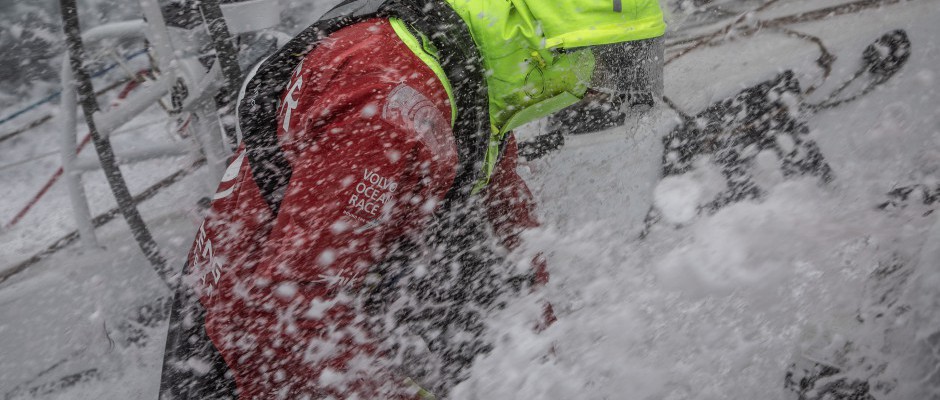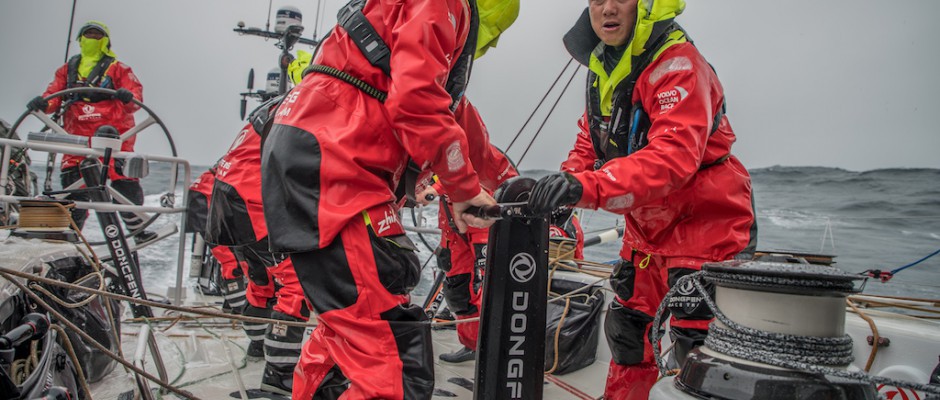Instructions: ‘Geek Only’ alert!
Capturing the uncatchable with the little means at our disposal. Capturing a wide angle shot of our craft rocking and rolling around this vast ocean. It’s a first for us On-board Reporters and a first for me aboard Dongfeng this morning.
It’s a first that became possible a few years ago thanks to the considerable evolution in drones and aerial footage. As with all ‘first times’, the apprehension is kicking in and I wanted to wait for the right time, the right light and the right feeling. The guys on-board explain to me that we’re going to cross tacks with MAPFRE for the third time since this morning. The swell is relatively well structured, there’s a stable breeze of a good 20 knots or so and there are no squalls on the horizon… so now’s the time.
I sneak into my cave to snap up the toy, do a quick check of the batteries and the card and we’re good to go. I decide to begin by assembling the beast down below, protected from the moisture and the waves sweeping the deck. I take care to preheat the machine before coming out of my hidey-hole, given the outside temperature, which is below 10 degrees or so. Everything fires up and inevitably the control screen is flooded with alert messages, compass calibration and so on, magnetic alert, IMU… blah blah blah.
Turning on this machine, which is supposed to communicate via GPS with satellites, from inside a box reinforced with carbon wasn’t the best idea I’ve ever had. Anyway, I assemble the propellers - the right way round works better I find - and I tuck the aircraft in my foulie top to sidestep any potential plumes of water that await me on the way out.
Stage 1 is a success in part and now I’m in the boat’s aft section, ready to get this thing airborne for the first time in my life, in this ocean and in these conditions. I switch the creature back on, the compass alert thing flashing… again. Ultimately, I decide I’m not too bothered about the compass. I’ve never needed to fly in GPS mode so I skip this calibration, which could well fail in any case and then compromise my flight.
I can feel the boat pick up speed beneath my feet, then she buries into the wave and a solid breaker hoses down the deck. I mustn’t dawdle around too much and the drone will be drier in the air than on this washing machine.
I activate the controls to get the motors running. It works. The preheat down below was useful. I hold the drone at arms’ length and give it full throttle and it’s off on its 20-minute flight; at least I hope that’s the case. The stress of the take-off phase is over and now there’s no time to lose, I have to focus on the image.
MAPFRE positions her bow towards the horizon. The morning light is beautiful, white and powerful, showing off the sea in all her glory. It’s a cold, intense blue that pierces the image on my little monitor. It’s magical. The drone links together a sequence of rotations, following the boat and performing other manœuvres around the red and white hull, which is surfing along of her own volition down the long Indian swell.
For the return home, let’s not risk losing its images. I attack what is the most critical phase of the flight for me. Let’s try to land this thing on the boat rather than on the sea, preferably without hitting one of the numerous cables that support the rig on the VO65. The first attempt comes very close to catastrophe, with the boat burying into a wave that I hadn’t sensed. The drone comes within a metre of me catching it with my left hand, when I watch it continue on its way like a grown-up, between the windward runner (cable that supports the mast) and the tower housing the telecommunications aerials. Whether it was a stroke of luck or a reflex action, I activate the right control to immediately send it backwards and out of danger.
Right, this time, I’m going to ask the on-watch helmsman, Kevin Escoffier, to tell me if any waves are coming so I can attempt to land, on the boat I mean, and hence reduce the risks. This time it comes good; a slight calming of conditions and the drone positions itself directly in front of me and all I have to do is to snap it up and wait for the motors to quickly stop the propellers, which even when they’re not under power, can cause damage.
I return to the calm, dry environment down below, the drone still in my foulies. The tension eases and the toy is back in its box again. I’ll leave you to it for now whilst I go and discover the images that have been recorded, process them and then share them with you as soon as possible.
_______________
VERSION FRANÇAISE
Mode d’emploi : Alerte Geek Only !
Saisir l’insaisissable avec nos petits moyens. Capturer un plan large de notre embarcation oscillant sur ce vaste océan. Une première pour nous les Onboard Reporter et pour moi à bord de Dongfeng Race Team ce matin. Une première devenue possible depuis quelques années grâce à l’évolution considérable des drones et de l’image aérienne. Comme pour toutes premières, l’appréhension est au rendez-vous et je voulais attendre le bon moment, la belle lumière, le bon feeling. Les gars à bord me précisent que nous allons croiser MAPFRE pour la troisième fois depuis ce matin, la houle est relativement ordonnée, le vent, d’une bonne vingtaine de nœuds est stable et pas de grain à l’horizon…c’est l’occasion. Je me faufile dans ma caverne pour saisir le jouet, petit check des batteries, de la carte et c’est partie. Je décide de commencer à monter la bête à l’intérieur, à l’abri de l’humidité et des vagues qui balaient le pont. Je prends garde à procéder à la préchauffe de la machine avant de sortir de ma cachette considérant la température extérieure qui se situe en dessous d’une dizaine de degrés. Tout se met en route et évidement l’écran de contrôle se voit inondé de messages d’alertes, compas calibration machin truc, magnetic alerte, IMU… bla bla bla.
Allumer cet engin qui est censé communiquer par GPS avec des satellites à l’intérieur d’une boîte blindée de carbone n’était pas l’idée la plus brillante que j’ai eue. Allez, je monte les hélices, dans le bon sens c’est mieux, et j’enfouis l’aéronef dans mon haut de ciré afin de passer les potentielles chutes d’eau qui m’attendent à la sortie. Etape 1 réussite en partie, je me retrouve maintenant à l’arrière du navire prêt à faire voler ce truc pour la première fois de ma vie dans cet océan et par ces conditions. Je rallume la bestiole, compas alerte truc… encore. Bon finalement, je m’en fiche un peu de ce compas, je n’ai jamais eu besoin de voler en mode GPS donc je fais l’impasse sur cette calibration qui risquerait de toute façon d’échouer et de compromettre mon vol. Je sens sous mes pieds le bateau prendre de la vitesse, il plante et une belle déferlante, nettoie le pont, je ne dois pas trop traîner, le drone sera plus au sec dans les airs que sur cette machine à laver.
J’actionne les commandes pour mettre les moteurs en route, ça marche, le préchauffage intérieur a été utile, je tends le drone à bout de bras et envoie les gaz, c’est partie pour 20 minutes de vols, enfin j’espère. Le stress de la phase de décollage est passé, maintenant inutile de perdre du temps et soyons focus sur l’image. MAPFRE pointe son étrave à l’horizon. La lumière du matin est belle, blanche et puissante, elle met parfaitement en valeur la mer, c’est un bleu froid et intense qui perce l’image sur mon petit moniteur. C’est magique, le drone enchaîne les rotations, suivis et autres mouvements autour dela coque rouge et blanche qui surfe librement la longue houle de l’Indien.
Retour maison, ne prenons pas le risque de perdre ses images. J’attaque alors la phase la plus critique du vol pour moi. Essayons d’atterrir et non d’amerrir, et de préférence sans heurter l’un des nombreux câbles qui soutiennent le gréement du VO65. La première tentative ne passe pas loin de la catastrophe avec le bateau qui plante dans une vague que je n’avais pas sentie. Le drone était à un mètre de se faire agripper par ma main gauche quand je le vois continuer sa course comme un grand entre la bastaque au vent (câble qui soutient le mât) et la tour avec les antennes de télécommunication. Coup de chance ou reflexe, j’actionne la bonne commande pour le renvoyer aussitôt en arrière et hors des dangers. Bon, cette fois je vais demander au barreur du quart, Kevin Escoffier de m’annoncer les vagues à l’approche pour tenter d’atterrir, je dis bien d’atterrir, et ainsi de diminuer les risques. Cette fois, c’est la bonne, une petite accalmie et le drone se positionne parfaitement devant moi, je n’ai plus qu’à le saisir et atteindre les moteurs pour vite stopper les hélices qui peuvent, même sans puissance, faire des dégâts. Retour au calme, au sec et à l’intérieur, le drone toujours dans mon ciré. La tension retombe, le jouet est de nouveau dans sa boite.
Maintenant, je vous laisse, je vais aller découvrir les images enregistrées, les traiter et vous les faire partager le plus vite possible.














